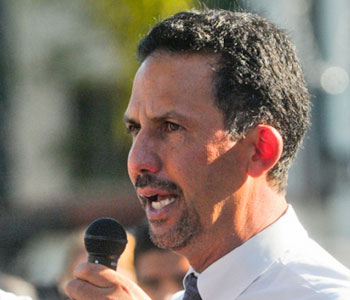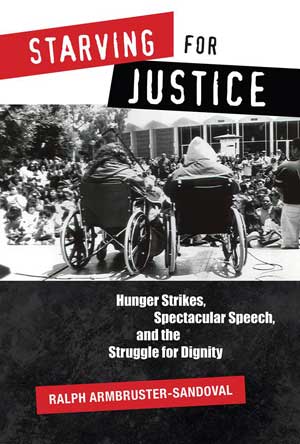
Starving for Justice examines three hunger strikes that took place in the 1990s on university campuses. Twenty years ago, Chicana/o, Latina/o students at UCLA, UC Santa Barbara, and Stanford stopped eating. Anti-immigrant measures like Proposition 187, mass incarceration, rising racial and economic inequality, globalization, budget cuts, and higher tuition costs morally outraged many. Having exhausted all other mechanisms for redressing their grievances, they embraced César Chávez’s perhaps mostly widely-known and controversial tactic for creating social change—the fast or “hunger strike.”
Chávez’s initial fast lasted twenty-five days in 1968. Before he died in April 1993, the iconic and sometimes autocratic labor and civil rights leader endorsed a long-standing demand to create a Chicano Studies Department at UCLA. Several days after his death, UCLA Chancellor Charles Young rejected this proposal, which Chicana/o students, faculty, and community members had been making for twenty-five years. Young’s decision, along with a nonviolent demonstration that resulted in nearly one hundred arrests, essentially lit the match that sparked a two-week long hunger strike at UCLA.
Approximately one year later, Chicana/o, Latina/o students at UC Santa Barbara, the first UC campus to establish a Chicano Studies Department in 1970, went on a nine-day hunger strike. Besides calling for a stronger department with more faculty and a graduate program in Chicano Studies, these students demanded more resources for recruiting and retaining eligible Chicana/o high school students, banning table grapes from campus, creating a community center in nearby Isla Vista, and maintaining critical “safe spaces” where Chicana/o, Latina/o students had met for generations.
Just one day before this strike ended, another one emerged at Stanford. Unlike the other two public universities, this action took place on a highly prestigious private and generally quite conservative campus. When Provost Condoleezza Rice fired beloved and long-time Stanford administrator Cecilia Burciaga, Chicana/o, Latina/o students fought back. This action, along with other racist incidents on campus, sparked a three-day hunger strike that involved four Chicana students. Like their counterparts at UCLA and UCSB, these students called for creating a Chicano Studies Department, eliminating table grapes, and building a community center in East Palo Alto where many Latina/o campus service workers lived.
Since the late 1980s I have been involved in social movements. Activists that went “all the way,” putting their bodies on the line, risking arrest, going on hunger strike, and so on always fascinated me. I had great respect and admiration for people like Gandhi, Bobby Sands, César Chávez, Oscar Romero, and many others who were willing to die for their beliefs. I always wondered if I could go as far as they did.
I was hired at UC Santa Barbara in the Chicana and Chicano Studies Department in 1998, just four years after the hunger strike ended. One of the students’ demands was for the administration to hire more faculty in the department. After some back-and-forth negotiations, both sides agreed on that issue (with the students wanting many more professors than they actually got), and I started working in the department. In other words, without these students’ sacrifices I would have never gotten this job.
Upon arriving I often heard from students associated with El Congreso, the organization that initiated and led the hunger strike, that they hoped someone would write a book or possibly produce a documentary film about the nine-day protest. After finally finishing another book project, I started collecting primary sources and interviewing people for what became Starving for Justice.
Aside from the three “case studies” of hunger strikes (which have never been fully documented and analyzed before in one full volume), this book makes a critical theoretical intervention. I contend that hunger striking—like self-immolation to a degree—is designed to grab the public’s attention. It is designed to make people “wake up” and see suffering and misery.
In the early 20th Century, women in England, Ireland, and the United States mobilized for voting rights. When many activists were jailed, they resorted to going without food. Their “spectacular speech,” including states which force-fed them to keep them alive, sparked widespread moral outrage and concern. It is ironic that women pioneered this particular tactic and yet men (including those named above) are most often recognized and lionized for making the “ultimate sacrifice.”
These gendered dynamics help explain why I deliberately selected the Stanford hunger strike since that action involved Chicana students. I suggest that one reason why this protest has garnered such scant attention is that it involved women of color whose bodies are often called into question.
In sum, I argue that in the early 1990s, twenty-five years after the turbulent and widely-examined 1960s, Chicana/o, Latina/o students “screamed” and dreamed of a new world, a world, as the Zapatista movement in Mexico declared, “where many worlds fit.” While these students had specific campus-based demands, one should not overlook the fact that they had a broad vision of change. They simply wanted dignity for all, especially for Chicanas/os, Latinas/os who were being singled out yet again for national and state economic crises.
Make no mistake. These hunger strikes were “race-based,” but the students who went without eating and organized behind-the-scenes had bigger “freedom dreams,” as famed historian Robin D.G. Kelley might put it. These students “raged against the machine” and they won. More faculty were hired, Chicana/o Studies Departments were created/strengthened, Chicana/o, Latina/o student enrollment surged, but this does not mean the struggle is over. Far from it, as we see mass deportations and mass incarceration, along with new fights around “political correctness.” The struggle continues, as it always will.
I would hope that readers would flip to chapter two, titled “Speak About Destruction.” In the mid-1980s, a band called “Time Zone,” featuring former Sex Pistols lead singer Johnny Rotten and hip-hop artist Afrika Bombatta, released their most popular hit titled “Speak About Destruction.” Its lyrics include these lines: “Speak about destruction. The rich get richer, the poor get poorer, nationalities fighting amongst each other. Why? Because the system tells you to.”
The 1980s and 1990s were destructive. Key gains that people of color, workers, queer people, and students made some two decades earlier were being rolled back. Outside the United States, especially in Latin America, people’s everyday lives were harsh, as mass repression existed particularly in nations such as Guatemala and El Salvador. In South Africa, millions pressed for abolition of apartheid, with activists all over the world working in solidarity for that same cause.
Chapter two chronicles what was going on in the world, in the United States, and in California. It identifies the larger coyuntura or conjunctural moment that existed in the early 1990s that led up to these three hunger strikes. In Frantz Fanon’s memorable words, 1994 was the “year of the boomerang,” when marginalized communities rose up, with arms initially in Chiapas, with bodies on university campuses in California. Fanon’s comment suggests, as Malcolm X once stated, the “chickens have come home to roost.”
Relatively powerless people can only be pushed around for so long before they say “no.” Within that “no” is a powerful “yes”—a yes to a world without poverty, injustice, violence, racism, and sexism. Thus, what these students were saying was NO. They were screaming for a new world, putting their bodies and lives at risk. They were willing to die so that they and others could simply live.
So often people say “one person can’t really do anything,” but this book indicates otherwise. All these hunger strikes were collective. Oftentimes we associate hunger strikes with an iconic, heroic individual, but these actions could not exist without many other people making flyers, negotiating with powerful officials, creating solidarity networks, and so on.
The students on these campuses were relatively successful. They slowed down the machine and brought about greater dignity to those on the margins. And yet, much has happened over the past twenty-five years. A quarter-century has nearly passed since these hunger strikes took place.
One could reasonably argue similar conditions that existed in the 1990s continue today; in fact, things might have gotten worse. Given this situation, students and many others are putting their bodies on the line. They have a deep desire and hunger for justice. One could only hope that they will succeed. The stakes are extremely high—perhaps amongst the highest they have ever been.
This madness must stop now before it’s too late. As singer-songwriter Jackson Browne said in the 1980s, there are “lives in the balance,” people are “under fire.” I hope that people walk away from reading this book feeling inspired that despite it all change is possible. Another world, another university is possible!


Ralph Armbruster-Sandoval is a professor in the Chicana and Chicano Studies Department at the University of California, Santa Barbara (UCSB). He is the author of two books, Globalization and Cross-Border Labor Solidarity in the Americas (Routledge, 2005) and Starving for Justice: Hunger Strikes, Spectacular Speech, and the Struggle for Dignity (University of Arizona Press, 2017), which is featured in his Rorotoko interview. He is currently working on a new book on the Chicana/o Movement in Los Angeles, post-1960s.